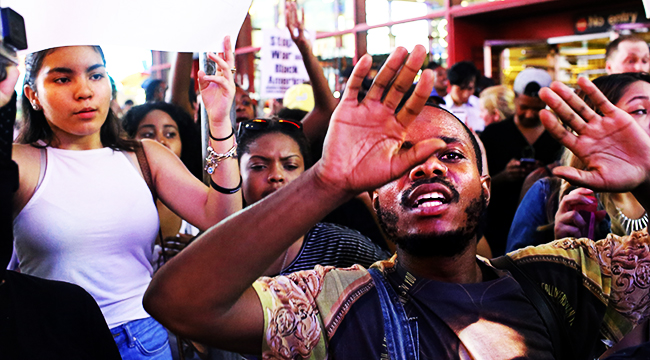
Data has shown that, across the country, black Americans are more likely to be killed by police than whites. But the problem is worse in the most segregated states, according to a recent study showing that racial disparities in fatal police shootings are linked to histories of structural violence.
Police killings, more than just the consequence of a few bad-apple officers that can be rooted out of the system, instead can be traced back to the discriminatory housing and economic policies of the mid-20th century, the study’s senior author, Michael Siegel, told The Intercept.
To conduct their analysis, Siegel and his colleagues at Boston University’s School of Public Health compared two numbers for each state: the black-white ratio in the rate of fatal police shootings from 2013 to mid-2017, and something the authors termed a “racism index.”
For the former statistic, they pulled data from the Mapping Police Violence project database, one of the most comprehensive aggregations of police-involved deaths in recent years. (Other studies have found that government-collected data on homicides, like those of the FBI and the Centers for Disease Control, severely underestimate the actual number of fatalities from police shootings.) To measure structural racism, the researchers used different government sources, such as the U.S. Census Bureau and the Bureau of Justice Statistics, to create an index for each state based off factors like residential segregation, as well as gaps in incarceration rates, educational attainment, economic class, and employment status between black and white people.
Of all the symptoms of structural racism, the factor that had the strongest relationship with police shooting disparities was residential segregation, followed by economic inequality.
Overall, for every 10-point jump in a state’s racism index, researchers found a 24 percent increase in the black-white ratio of fatal police shootings of unarmed victims. Starker still is the isolated effect of housing segregation: For a similar 10-point jump in a state’s segregation index, there was a 67 percent increase in the ratio of police shooting deaths. In other words, living in a highly segregated state severely increases the chance that an unarmed black civilian will die in an officer-involved shooting.
This means that even attempts to reform police departments through programs like implicit bias training and police body cameras are inadequate, says Siegel. “These are solutions that try to intervene right at the last possible moment,” right before or during the moment an officer pulls the trigger, he said. In reality, the foundation for racialized police violence was laid by political and economic institutions created many decades ago, through mechanisms like Jim Crow-era redlining and so-called sundown town policies. “It’s not just about how individuals interact,” says Siegel, “but how society is structured.”
Surprisingly, the highest black-white ratios of police killings are concentrated in the Midwest, as are broader disparities in outcomes and living conditions like segregation and economic status. Among the states with the highest disparities in black versus white shooting victims and the highest racism index scores are Wisconsin and Illinois — home, respectively, to Milwaukee and Chicago, two of the most segregated cities in the country. While Siegel and other researchers conducted the study on the state level, they plan to continue conducting research on a city-by-city scale. Many of the highest-profile fatal police shootings over the last five years have occurred in the Midwest, including those of Laquan McDonald (Illinois), Philando Castile (Minnesota), Rekia Boyd (Illinois), Sylville Smith (Wisconsin), and Michael Brown (Missouri).
Southern states, contrary to popular perception, show less of a difference between black and white people in both fatal shootings and living conditions.
“It shows that this is not as simple as saying there’s more racism in the South,” says Siegel. “In parts of the Midwest, we have these highly segregated neighborhoods that police view in certain ways.”
The study also found that overall, unarmed black civilians are more than four and a half times more likely to be shot dead by the police than unarmed white civilians. The data also includes instances in which law enforcement maintains a victim was armed at the time of a shooting, even when that fact is disputed — which could mean a potential undercount in the rate of police shootings of the unarmed victims.
Social scientists have used two different theories to explain the racial disparity in officer-involved deaths. The first is that higher levels of interaction between police and black communities, supposedly a reflection of increased crime in those communities, lead to more fatal police shootings of black Americans. The second theory points to racism that influences interactions between law enforcement and black civilians. But even when the BU researchers controlled for the arrest rate of black individuals, a measure of interaction levels between officers and civilians, they still found that structural racism had a strong effect on the fatal police shootings of black individuals, lending more credence to the second theory, according to Siegel.
As with any academic study, there are caveats. For instance, Siegel urges readers not to take police shooting rates in states with smaller populations at face value. Maine, for example, has the highest ratio of black-white fatal police shootings, but Siegel says, “There’s just such a small number of black people in Maine to begin with that if you even have one person being shot, it appears to be a really high rate.”
One of the most notable takeaways from the study is that it frames police violence not only as a criminal justice issue, but as a critical public health issue. “It’s pretty dramatic to think about what happened decades ago having a public health impact right now,” says Siegel. “Fatalities are health outcomes. This is really about racial disparities in health outcomes and the health and safety of an entire population. We really need to look at it as such.”
The post A Hidden Factor in Police Shootings of Black Americans: Decades of Housing Segregation appeared first on The Intercept.
